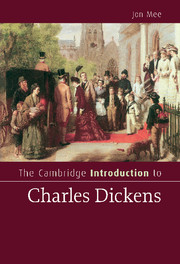Book contents
- Frontmatter
- Contents
- List of illustrations
- Preface
- Chronology
- List of abbreviations
- 1 Dickens the entertainer: ‘People must be amuthed’
- 2 Dickens and language: ‘What I meantersay’
- 3 Dickens and the city: ‘Animate London … inanimate London’
- 4 Dickens, gender, and domesticity: ‘Be it ever … so ghastly … there's no place like it’
- 5 Adapting Dickens: ‘He do the police in different voices’
- Afterword: Dickens's world
- Notes
- Further reading
- Index
- Cambridge Introductions to …
3 - Dickens and the city: ‘Animate London … inanimate London’
Published online by Cambridge University Press: 05 August 2012
- Frontmatter
- Contents
- List of illustrations
- Preface
- Chronology
- List of abbreviations
- 1 Dickens the entertainer: ‘People must be amuthed’
- 2 Dickens and language: ‘What I meantersay’
- 3 Dickens and the city: ‘Animate London … inanimate London’
- 4 Dickens, gender, and domesticity: ‘Be it ever … so ghastly … there's no place like it’
- 5 Adapting Dickens: ‘He do the police in different voices’
- Afterword: Dickens's world
- Notes
- Further reading
- Index
- Cambridge Introductions to …
Summary
What is Dickens trying to describe? More often than not, it is London. He boasted in 1866 to know the city ‘better than any one other man of all its millions’. Certainly he began his complex relationship with the place early. John Forster started his biography with an account of how as a child being
taken out for a walk into the real town, especially if it were anywhere about Covent-garden or the Strand, perfectly entranced him with pleasure. But, most of all, he had a profound attraction of repulsion to St. Giles's. If he could only induce whomsoever took him out to take him through Seven-dials, he was supremely happy. “Good Heaven!” he would exclaim, “what wild visions of prodigies of wickedness, want, and beggary, arose in my mind out of that place!”
(Forster 11)For many readers today, Dickens is nineteenth-century London and vice versa. Television and film directors spend immense amounts of money recreating authentic scenes of dilapidation and mud on the supposition that his fiction provides a window onto the nineteenth century and, above all, the street life of the city. The name ‘Charles Dickens’, of course, is part and parcel of the heritage London still sells to tourists today. A series of guidebooks even exists – Walks in Dickens's London – devoted to particular parts of the city and their relationship to the novels and the life of their author (a distinction not always very clearly maintained).
- Type
- Chapter
- Information
- The Cambridge Introduction to Charles Dickens , pp. 43 - 63Publisher: Cambridge University PressPrint publication year: 2010



